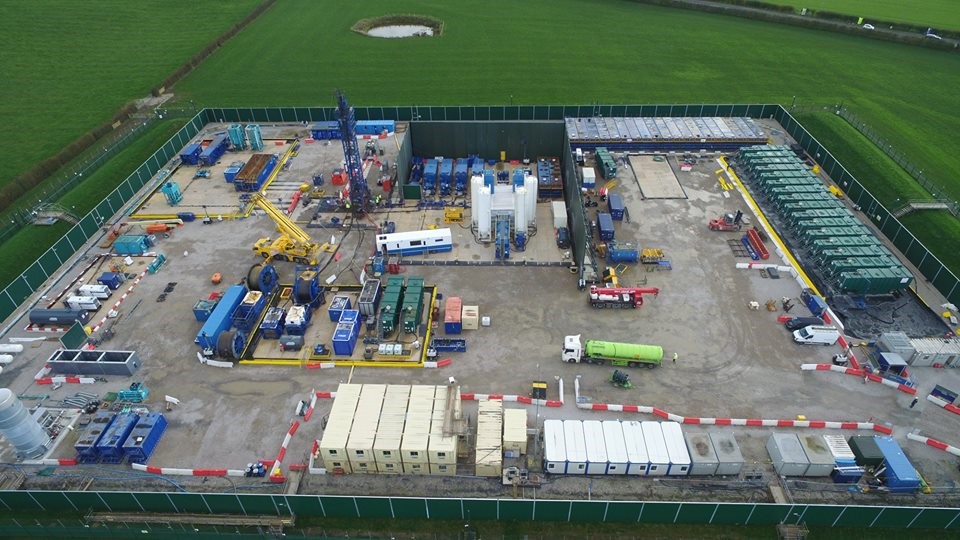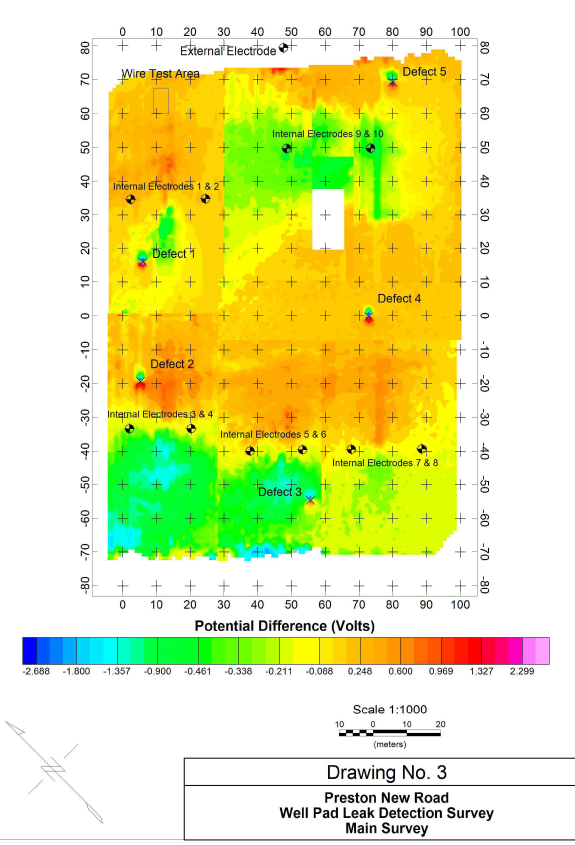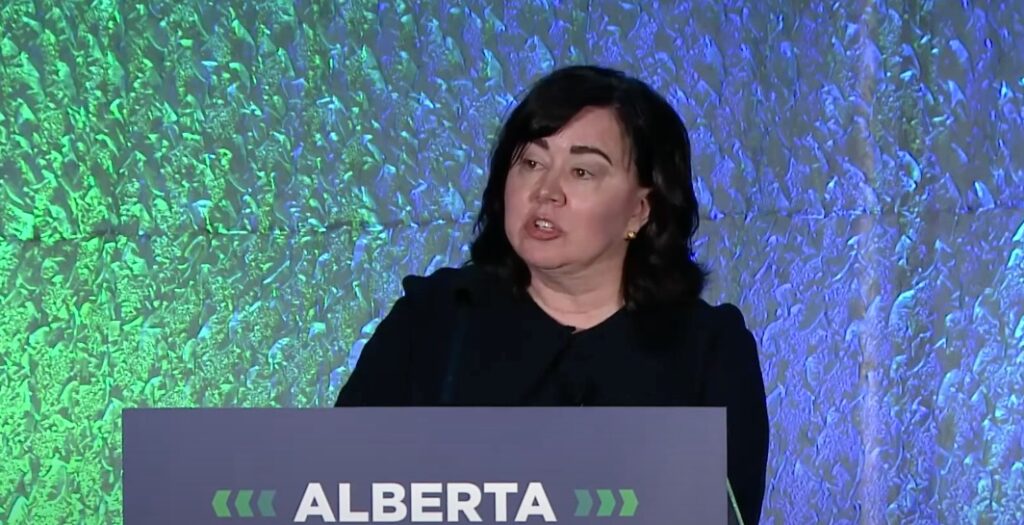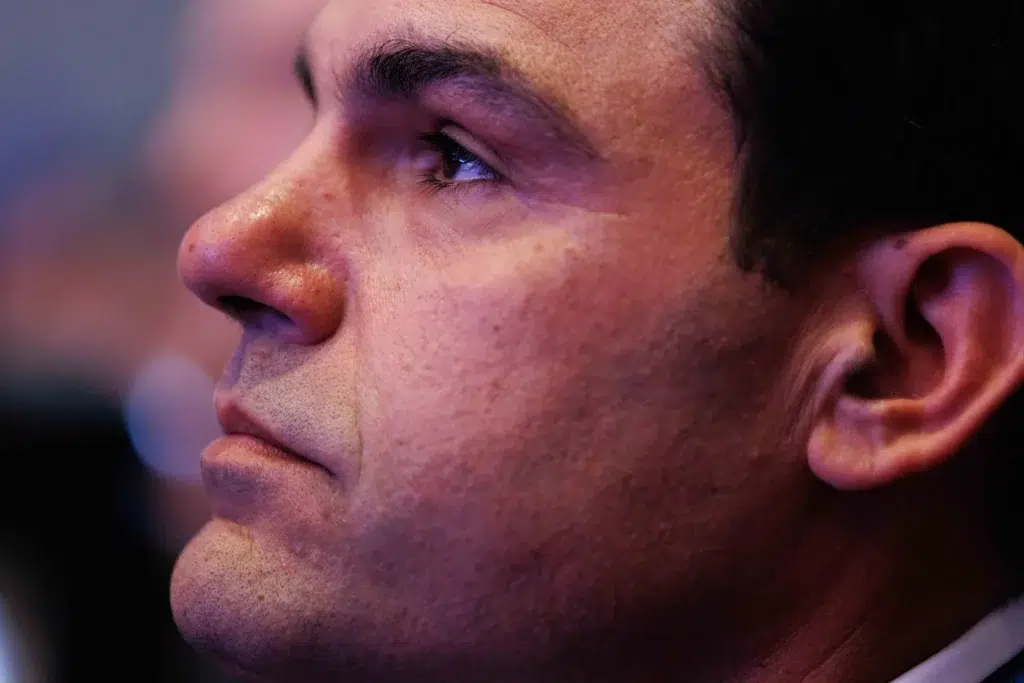Shale gas exploration company Cuadrilla has breached environmental permits multiple times and failed to disclose full details of technical issues at its Lancashire site, a DeSmog UK investigation has found.
The company breached its environmental permits seven times in 10 months in 2017, analysis of Freedom of Information requests and publicly available Environment Agency Compliance Assessment Reports shows.
DeSmog UK’s investigation also uncovered a survey commissioned by the company that identified faults with a protective membrane, despite the company telling local residents it had never needed repairs.
British Geological Survey data also shows Cuadrilla experienced six tremors within eight days after it commenced fracking in October 2018. Fracking had to be halted for a second time after a magnitude 0.8 tremor on Friday.
The investigation also revealed that the Environment Agency, which is tasked with ensuring the site operates within agreed environmental parameters, encountered problems with air pollution monitoring at the site due to faulty equipment.
Campaigners told DeSmog UK that the findings gave them “no confidence” that the government could implement promised “robust” regulations, as ministers seek to encourage fracking across the country.
Academics told DeSmog UK that the findings show the need for Cuadrilla and regulatory authorities to share more information with independent experts to avoid speculation that the company is trying to hide unsafe practices.
Cuadrilla told DeSmog UK that it acknowledged the “minor” breaches, but maintained its practices were safe for the environment. A spokesperson for the company said:
“We accept there have been minor and non-significant breaches and these are already a matter of public record. It is important to note that Cuadrilla proactively reported to the Environment Agency in line with our permits. In all cases there was no negative impact on the environment and there has been no action against Cuadrilla by the Environment Agency.”
Breaches
The Environment Agency reports state that the significance of the breaches DeSmog UK found ranged from “not regarded as a serious issue” to issues where “improvements are required” to comply with the law.
A spokesperson for the Environment Agency told DeSmog UK that to date it had issued Cuadrilla with warnings for five non-compliances at the site. DeSmog UK found evidence of seven breaches among the Environment Agency’s assessment reports.
The breaches relate to how Cuadrilla handles waste on site, manages water, and takes responsibility for waste once it has left the site.
Breach 1 | 02 March 2017 | Unpermitted release into a nearby Brook and ‘inadequate’ management systems
The Environment Agency warn Cuadrilla over “two incidents involving the discharge of surface water containing silt” into the nearby Carr Bridge Brook.
The first incident occurred on the 27 February 2017 and was caused by “a surface water management problem”.
The second incident was caused by an escape of silt-containing water from Cuadrilla’s well pad.
The EA also warned Cuadrilla that its water management systems were found to be “inadequate” and required “improvement” to prevent escaping water from causing pollution.
Breach 2 & 3 | 14 June 2017 | Unpermitted discharge of ‘contaminated surface water’
On the 14 June 2017, the Environment Agency inspected the Preston New Road well pad. During the site inspection, Cuadrilla informed the regulator of an unpermitted “discharge of silt contaminated surface water” from the fracking site.
According to the Environment Agency’s report dated 6 October 2017, “the escape of silt contaminated surface water had occurred through an electrical conduit inside an interceptor chamber”.
The report also noted that the contaminated waste “spilled onto ground which spread across land” and eventually ended up draining into a nearby water tributary, the Carr Bridge Brook.
The EA subsequently conducted its own tests and did not identify any pollution caused by this incident and concluded that “any impact on the tribuary (sic) of Carr Bridge Brook would have been minimal”.
Cuadrilla were warned for breaching two permit conditions: the first for failing to notify the regulator of the event and the second for the unpermitted leak.
Breach 4 | 1 August 2017 | Failure to store waste correctly
On this occasion, the Environment Agency discovered the firm was failing to store its drilling waste correctly. Drilling cuttings are the waste dirt and broken bits of rock removed from a borehole as part of the underground drilling process, and may contain naturally occurring radiation and chemicals.
The inspection report notes that Cuadrilla was using standard metal skips to store the “spoilt” drilling waste. These, it found, were not “hydro tested for leaks” or “appropriately certified for integrity” as required under the agreed waste management plan, which classifies spoiled drilling waste as hazardous.
This non-compliance, the EA warned, could “foreseeably result in a minor environmental effect”. “This is not regarded as a significant issue”, the report states.
The Environment Agency ordered the firm to use the correct storage containers and conduct both weekly visual integrity checks and annual thickness testing.
Breach 5 & 6 | 23 November 2017 | Regarding site drainage and the prevention of emissions
These breaches were identified on an independent database. However, the Environment Agency is yet to release detailed assessment reports on the breaches. The only details available currently are that the breaches relate to criteria “B3 Infrastructure – site drainage engineering” and “B1 Infrastructure – engineering for prevent of emissions”.
Breach 7 | 7 December 2017 | Use of unpermitted site for storage of waste on at least 22 occasions
Cuadrilla broke the law and received a formal warning from the EA on the 25 July 2018.
The warning letter outlined how Cuadrilla had not taken reasonable measures to prevent extractive waste being temporarily stored at an unpermitted site.
It also stated that Cuadrilla had used non-unique consignment notes, providing incorrect name for the waste produce, incorrect consignee name, incomplete information about the waste’s relevant chemical components with their concentrations and wrong hazard codes.
The 22 separate occasions that Cuadrilla stored waste at an unpermitted location were observed over a period of three months between 7 March 2017 and 9 March 2018.
The assessment report does note, however that the Environment Agency “can conclude that overall waste drilling muds and cutting were treated and disposed in line with sound waste management practices”.
The Environment Agency gave Cuadrilla notice that “further checks will be carried out within 3 weeks” to check the company had addressed the issues.
A spokesperson for the Environment Agency told DeSmog UK that “oil and gas operators must meet the highest environmental standards which are set out in law.”
The agency said minor non-compliances are not unusual after site inspections and audits, and that it works hard with developers to address these.
A spokesperson for Cuadrilla told DeSmog UK that it continued to work with the Environment Agency to ensure it complied with environmental standards. A spokesperson said:
“In terms of the specific breaches, they are publically reported by the EA.”
“Earlier this year, the EA completed a comprehensive waste management audit which included the contributions made by our contractors and sub-contractors. The EA concluded that overall they were satisfied that the audited waste streams were removed from Preston New Road to appropriate waste facilities in line with good practice. We are confident that all waste streams have been treated and continue to be treated fully in accordance with the permits in place.
“The EA did note a number of minor non-compliance issues, although none impacted on how waste should have been or was treated. We have addressed these issues.”
Faulty Air Monitoring Equipment
The Environment Agency has had some problems monitoring all aspects of the site, however.
The Environment Agency deployed a ‘mobile monitoring facility (MMF)’ to Cuadrilla’s Preston New Road fracking site in August 2017 with the purpose of carrying out background level monitoring of different types of pollutants.
The regulator publishes the data from the MMF in a monthly air quality monitoring report. The September 2018 report notes numerous problems with the monitoring equipment:
|
Date |
Pollutants recorded |
Issue |
|
23 August 2018 – 9 September 2017 |
benzene, toluene, ethylbenzene and xylene (BTEX) |
No BTEX data recorded between these dates ‘due to technical problems with the instrument’ |
|
6 March 2018 – 6 April 2018 |
particulates (PM10) |
No data recorded between these dates. The measuring equipment was switched off ‘due to complaints about noise coming from the monitoring station’ by a local resident |
|
6 March 2018 – 12 April 2018 |
particulates (PM2.5) |
No data recorded between these dates. The measuring equipment was switched off ‘due to complaints about noise coming from the monitoring station’ by a local resident |
|
26 April 2018 – 1 May 2018 |
Methane (CH4) |
No Methane data recorded between these dates ‘due to technical problems with the analyser.’ |
|
29 June 2018 – 6 July 2018 |
benzene, toluene, ethylbenzene and xylene (BTEX) |
No BTEX data recorded between these dates ‘due to the instrument being removed for servicing’ |
The Environment Agency said equipment may occasionally be offline for routine maintenance or repairs.
Membrane Defects
Cuadrilla also appears not to be disclosing the full details of some environmental issues at the site.
A protective geomembrane layer helps to prevent contamination below the Preston New Road well pad. But a survey commissioned by Cuadrilla appears to identify defects with the layer — contradicting statements made in public by the company.
At a Community Liaison Group meeting between Cuadrilla and the local community held on September 10 2018, the company’s technical director Mark Lappin was questioned about the ‘integrity’ of the membrane layer. The meeting minutes note:
“Has the existing membrane been replaced or ‘patched up’? Mark Lappin explained that the integrity of the existing membrane remains and has not needed to be restored or repaired.”
A report sent by Cuadrilla to the Environment Agency seems to contradict Cuadrilla’s statement, however.
A redacted copy of a report titled ‘Geomembrane leak detection survey’ for the Preston New Road well pad, obtained through a Freedom of Information request, identified “five defects in the liner system” during a survey that took place between 20 June and 29 July 2017.
The purpose of the report was to “locate any damage to the placed geomembrane liner”.
The report is dated August 2017 was commissioned by Cuadrilla and emailed to the EA by Cuadrilla on the 7 September 2017.
Professor Richard Davies, a petroleum geologist at Newcastle University, told DeSmog UK that the data was insufficient to show “whether anything serious is wrong”.
However, he said it did show that “membranes aren’t a fail-safe mechanism for sealing the well-pad. It’s showing it’s not a perfect solution.”
The defects were subsequently repaired by Cuadrilla.
A spokesperson told DeSmog UK:
“The geomembrane was tested in 2017 prior to drilling operations getting started. The test highlighted some minor repairs were required and these were carried out. It has maintained full integrity since that time including testing post-drilling.”
Tremors
Cuadrilla has had some well-publicised issues with small tremors since it started fracking in October 2018, including six tremors within the first nine days of fracking. On Friday, it halted fracking for a second time after a magnitude 0.8 tremor, which registers as a “red light” on the government’s traffic light system.
Red light tremors of 0.5 magnitude or above require the company to suspend fracking immediately.
Records show that there have been multiple and frequent tremors since Cuadrilla started fracking.
Cuadrilla announced on the October 15 2018 that it had commenced with fracking at its Preston New Road well pad after a last-ditch injunction to stop the process had failed to halt the operator.
By the October 18 2018, the British Geological Survey (BGS) picked up three small tremors within very close proximity of Cuadrilla’s horizontally drilled well.
The three seismic events ranged in magnitude from -0.2 to -0.8 ML.
At this strength Cuadrilla were still within the Oil and Gas authority’s (OGA) ‘green’ zone on the seismicity traffic light system so fracking was allowed “proceed as planned”.
Three more earthquakes followed on the 19, 20 and 23 October. The magnitude of the tremors increased up to 0.4ML and into ‘Amber’ zone on the traffic light system, resulting in Cuadrilla having to “proceed with caution”. The tremor that occurred on the October 19 2018 was registered by the BGS only 15 minutes after a frack test had been completed by Cuadrilla.
The largest of the six tremors occurred on the 23 October 2018 at 2.45pm while Cuadrilla were actively fracking at PNR. Cuadrilla noted;
“The highly sensitive monitoring systems at and around Cuadrilla’s shale gas exploration site in Preston New Road have detected a seismic event within the company’s operational area (approx 4.8km3) of 0.4ML (Local Magnitude) this afternoon while hydraulic fracturing operations were ongoing.”
As a result of the Amber warning quake being registered, Cuadrilla took the decision to suspend operations for the day.
|
Date |
Time (UTC) |
Magnitude |
Region |
|
23/10/18 |
14:45:32.5 |
0.4 |
Blackpool, Lancashire |
|
20/10/18 |
03:44:01.4 |
0.0 |
Blackpool, Lancashire |
|
19/10/18 |
13:20:48.5 |
0.3 |
Blackpool, Lancashire |
|
18/10/18 |
23:44:41.9 |
-0.3 |
Blackpool, Lancashire |
|
18/10/18 |
22:54:46.8 |
-0.8 |
Blackpool, Lancashire |
|
18/10/18 |
15:48:53.6 |
-0.2 |
Blackpool, Lancashire |
Source: earthquakes.bgs.ac.uk
Professor David Smythe, a geologist and Emeritus Professor of the University of Glasgow, who is a prominent critic of the fracking industry, told DeSmog UK:
“It is normal for all these tiny tremors to be recorded, if a dedicated temporary seismic array is in place, as it is at Preston New Road.”
“Earthquakes below magnitude of two are not normally felt by humans, and are unlikely to cause any surface damage. Each increase of one unit on the scale means about 30 times more energy is released.”
“It is difficult to convert a given magnitude into damage or noise, because it depends on how deep the earthquake is. But in round terms, tremors of under a magnitude of three in the Fylde might be felt (as in a heavy lorry going past your door), but will not do damage.”
However, Smythe has previously expressed concerns that “even after nine years in the Fylde, to understand the geology”.
“The problem for Cuadrilla is that if it now carries on regardless after just five days’ fracking, bigger earthquakes are likely to be triggered”.
Smythe says he is concerned that the “strong impression is that Cuadrilla is once again trying to hide its own technical incompetence”.
It’s a viewed shared by local campaigners, who have been fighting the development for years.
Miranda Cox, a local councillor and prominent anti-fracking campaigner, who sits on the Community Liaison Group, told DeSmog UK she was “frustrated with communication”.
“Dissemination of information can be shrouded in industry language and is at times, obtuse. Questions are asked of Cuadrilla and the regulators regarding breaches and other issues; frequently these are deferred.”
“Public scrutiny of the site and regulators is keeping the focus on lapses of safety and good practice. The authorities whose remit is to keep us safe, are under-resourced and understaffed.”
“The number of issues encountered so far at this one site is indicative of what is to come. If this industry is to become commercially viable and is rolled out across the country, I have absolutely no confidence that the ‘robust regulations’ promised will ever emerge.”
Cuadrilla said it was aware of the tremors, and that these were to be expected. A spokesperson said:
“Of course we are aware of the series of tiny micro seismic events which have been recorded by the British Geological Survey (BGS) since we began hydraulic fracturing operations on October 15.”
“Cuadrilla and all the regulators working with us at the exploration site at Preston New Road were expecting micro seismicity to occur as we are hydraulically fracturing shale rock. These events are tiny movements being detected by sophisticated monitoring equipment around the clock.
“Everything is working as it should and being reported appropriately as part of the Oil and Gas Authority’s traffic light system. We’re comfortable that these micro-seismic events, even the one recorded on Friday, are far below anything that could be felt at surface or cause damage or harm.”
Newcastle University’s Professor Davies said Cuadrilla needs to share as much data as possible if it is to overcome speculation about the safety of its activities. He told DeSmog UK his research group was being “kept one step away from it”.
“We’re not getting enough information to be able to fully assess the impacts of fracking”, he said.
“The bottom line is we’re getting quite a lot of information. And it’s difficult to work out what is important and what isn’t. So there are risks.”
“Is this leakage tiny and doesn’t contain any toxic materials, or is it more significant than that? We just don’t know.”
“It’s pretty obvious from the US example that where there’s a lack of information it leads to suspicion and a lack of trust. And I think a lot of the issues around fracking are related to a lack of trust.”
Subscribe to our newsletter
Stay up to date with DeSmog news and alerts








